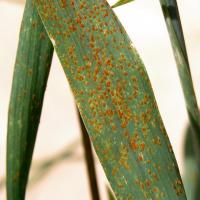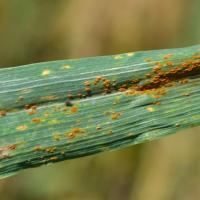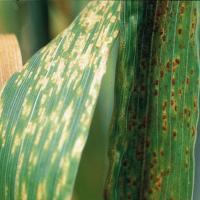Diagnosing leaf rust of wheat
Leaf rust (Puccinia triticina) is a fungal leaf disease specific to wheat that can pose a significant threat to the yield and quality of Western Australian wheat crops in some seasons, causing up to 30% yield loss in susceptible varieties.
What to look for
- Generally uniform infection across a crop, can start as 'hot spots' (foci) of infection in paddock from which disease rapidly spreads.
Paddock
- Small, circular to oval pustules with orange to light brown dusty spores on upper surface of leaves and on leaf sheaths in cases of heavy infection.
- Leaf rust spores are confined chiefly to the upper surface of the leaf and rarely appear on back of leaf except in seedlings.
- Pustules that go through the leaf surface to the back are more typical of stem rust.
Plant
What else could it be
| Condition | Similarities | Differences |
|---|---|---|
| Diagnosing stem rust of wheat | Leaf pustules | Stem rust pustules are brick-red and also occur on the stem and head |
| Diagnosing stripe rust of wheat | Leaf pustules | Stripe rust pustules occur in stripes rather than circular or oval |
Where did it come from?

Green bridge

Wet conditions
- Leaf rust requires green wheat host plants in order to survive from one season to the next. If summer rain allows a green bridge (of self-sown wheat) to develop, then the risk of early leaf rust on wheat crops can be significantly increased.
- Leaf rust can occur throughout the season because it develops rapidly in moist conditions when temperatures are between 10-20°C. A leaf rust epidemic is more likely if the winter or spring is suitably wet. The latent period of leaf rust (approximate time taken for an infection to result in new spores being produced) is 7-10 days in these optimal temperature conditions.
- Leaf rust can spread rapidly within and between wheat crops. Spores are readily dispersed by wind and can be carried on clothing. Thoroughly wash potentially contaminated clothes and shoes before visiting crops and consider farm biosecurity measures to minimise the likelihood of visitors introducing spores to your property.
- To identify leaf rust pathotypes that are new to WA, growers and consultants are encouraged to send rust samples to the Australian cereal rust control program at the University of Sydney.
Management strategies

Resistant varieties

Green bridge control

Seed treatment
- Avoid sowing susceptible varieties. Use resistant or intermediate varieties wherever possible.
- Destroy greenbridge plants at least four weeks prior to seeding (wheat volunteers that may harbour rust over summer and autumn).
- Registered seed or in-furrow fungicide treatments can provide protection until flag leaf emergence depending on disease pressure, variety susceptibility and application rates. Otherwise apply a preventative foliar fungicide spray at first node (Z31) to crops at risk of early infection. Apply registered fungicides at registered rates for leaf rust.
Economic and financial considerations
To assist in assessing the economic risk and financial costs associated with various treatment strategies go to MyEconomicTool
There may be other economic and financial implications that need to be considered when choosing a management option. These may include:
Pre-crop- Assess the risk of leaf rust occurring.
- Understand the potential yield losses associated with infection.
- Assess the costs and benefits of taking preventative action.
- Compare the costs, benefits and risk of each management option against doing nothing.
- Consider risk and associated costs or savings of delaying treatment.
- Consider the potential risk of re-infection and costs of further treatment.
- Ignore all previous treatment costs in assessing current management options.
- Undertake a “what if” scenario analysis to see what impact changing variables, such as grain price and season, have on the costs.
- Consider longer term consequences of not adequately treating leaf rust or controlling green bridges.
View these economic considerations in more detail.
How can it be monitored?
- Monitor crops from early stem elongation and apply a registered foliar fungicide at the first sign of leaf rust, taking into consideration the stage of crop development and variety susceptibility.
See also
Where to go for expert help
Page last updated: Tuesday, 3 May 2016 - 9:53am




